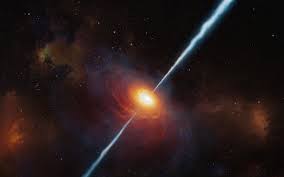My Research
Broadly, I am interested in the processes by which large-scale structures form and evolve along the cosmic timeline. In particular, I use major infrared-through-radio facilities to trace galactic features (e.g., cold molecular and atomic gas, dust emission, and starlight) in the hopes of studying the physics behind the most highly star-forming galaxies in the Universe and how they are shaped by their environments. I care a lot about the evolution of galaxy protoclusters from the epoch of reionization down to cosmic noon, particularly those that are anchored by massive systems --- radio galaxies, active galactic nuclei (AGN) and/or highly luminous quasars.
An infrared spectroscopic view of quasar environments
I am a member of the ASPIRE team (A SPectroscopic Survey of biased halos In the Reionization Era), which targets 25 z>6.5 quasars with JWST/NIRCam broadband imaging and WFSS, ALMA Band 6 imaging and spectroscopy, and a host of other instruments spanning X-ray to radio wavelengths. I am most interested in characterizing overdense environments of these luminous quasars to find evidence of star-forming protoclusters, as traced by [OIII] and [CII]. Stay tuned for results from our ASPIRE program!
Searching for companions around z>6 quasars
My master's project built on my work with Dr. Fabian Walter at MPIA, in which we used ALMA Band 6 observations of z=6 quasars to search for dust continuum overdensities. Such an overdensity would suggest evidence for early clustering around massive quasars, and these have been found with other tracers such as [CII] and Lyman-alpha. Interestingly, we did not find a statistical overdensity in continuum dust emission, but it's important to keep in mind that a continuum search probes Gpc scales: a true overdensity may exist but its signal could be washed out.
Indeed, in a followup paper we tried a complementary technique using HST to look for Lyman break-selected galaxies -- i.e., the less extreme star-forming galaxies than those traced by ALMA. In a subsample of three quasars, we found an extreme overdensity around one z=6.6 quasar, a moderate overdensity very close to a z=6 quasar whose overdensity profile is in line with those predicted for protocluster cores, and no overdensity around a z=6.9 quasar. These works highlight the genuine diversity of environments around quasars as well as the limitations of photometric selections to constrain overdensities.
Galaxy protoclusters near coalescence at z~2.5
Are DSFGs ubiquitous in protoclusters? Do all protoclusters go through starburst periods? Can the molecular gas trigger simultaneous starburst events in structures several comoving Mpc across? Working with a famous knot of the COSMOS Hyperion protocluster at z=2.5, we performed a full census of the molecular gas, dust, and stellar content, and have drawn exciting conclusions about the assembly of protoclusters across cosmic time. Most notably, protoclusters at z~2.5 mark an important transitional phase just before virialization, where extremely gas- and dust-rich galaxies begin to fall towards the dense central core, just before we see the smoking gun X-ray signature of the intracluster medium.


